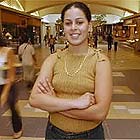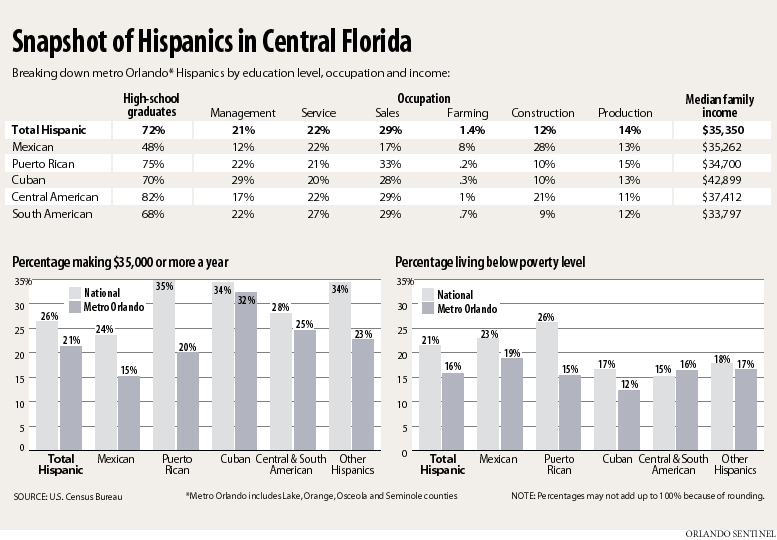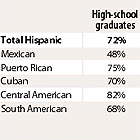|
 |
|
Esta página no está disponible en español. Study Finds Orlando Area Is A Magnet For Puerto Ricans…Numbers Depict Local Hispanics
Study Finds Orlando Area Is A Magnet For Puerto Ricans ADRIENNE LU June 19, 2003 From 1990 to 2000, the number of Hispanics living in Florida, Texas, California and New York increased from 16-million to more than 23-million - more Hispanics than lived in the entire country in 1990, said Charles Louis Kincannon, director of the U.S. Census Bureau. Detailed state and local statistics from the census will not be available until later this year. However, on Wednesday Gabriela D. Lemus, director of policy and legislation for the League of United Latin American Citizens, released the results of her study of three cities with emerging Hispanic populations - Orlando, Little Rock, Ark., and Cicero, Ill. The Orlando metropolitan area is the fifth-largest destination area for Hispanics in the country, Lemus said, with Hispanics making up 17 percent of the population and Puerto Ricans accounting for 56 percent of Hispanics. Lemus said the census estimates may undercount the true number of Hispanics in the Orlando region, however. One reason is that many Puerto Ricans travel frequently between Florida and Puerto Rico. Another is that some Hispanics may have classified themselves as white, although the census counts Hispanics of all races. The census deadline, April 1, means those who return to Orlando for the summer are not counted. And some Hispanics declined to participate. Lemus found that Hispanics in the Orlando region are more highly educated than the national average. Of Hispanics who were at least 25 years old, 72 percent had at least a high school degree or a GED. Lemus said the Orlando region has had some difficulties accommodating all the Hispanic newcomers. Some schools, for example, have had trouble finding enough teachers to teach English as a second language, while others have grown overcrowded because of fast population growth, regardless of ethnicity. Emergency services have had difficulty finding bilingual personnel to meet the needs of the region, Lemus said. And an August health care summit in Orlando found that Hispanics in the Orlando area received worse care than non-Hispanics, based on a number of measures - for example, Hispanics were less likely to receive diagnostic tests for diabetes, strokes or cancer and less likely to undergo bypass surgery or angioplasty.
Numbers Depict Local Hispanics By Jeff Kunerth | Sentinel Staff Writer June 19, 2003
GRAPHICS: Snapshot of Hispanics in Central Florida (ORLANDO SENTINEL) Wivy Alvarado, a 21-year-old Puerto Rican, says she's a perfect fit for her job as assistant store manager at the 5-7-9 clothing store at the Orlando Fashion Square mall. Next door, at the Foot Locker, the store manager is also Hispanic. So are many of the sales personnel who work in the clothing stores, shoe shops and fast-food restaurants scattered throughout the mall. Shopkeepers such as these are the human faces behind new data released this week by the U.S. Census Bureau, painting the most comprehensive picture to date of the lives of Hispanics in Orlando. The new numbers go much further than confirming Hispanics as the nation's fastest-growing minority group. The numbers reveal, in microscopic detail, where Hispanics work, what they make and how far they went in school. The statistics show that a third of metropolitan Orlando's Puerto Rican population is employed in sales occupations -- a fact reflected in the stores of Fashion Square. For Alvarado, the choice of job was influenced by her aunt, who worked in a clothing store and helped Alvarado get her first sales job at age 15. "Sales fits my personality. I'm high-spirited, outgoing," Alvarado said. "A desk job gets boring. I have to be talking to someone all the time." Her ambition is to move up in retail management, joining the other 22 percent of Puerto Ricans in Orlando employed in management and professional jobs. The census data also document the movement of Central Florida's Mexican population from the fields to the construction sites. Only 8 percent of the Mexicans in Orange, Osceola, Seminole and Lake counties work as farm laborers, while 28 percent are employed in construction.
"I think it's both," said Gabriela D. Lemus, director of policy and legislation for the League of United Latin American Citizens. Lemus said that in addition to higher wages for construction work, it is common for the children in Mexican families to work and contribute to the family income: "The kids come here to work, and they work very hard." Cubans have the highest median family income among metropolitan Orlando Hispanics at $42,899, followed by Central Americans at $37,412, Mexicans at $35,262, Puerto Ricans at $34,700, and South Americans at $33,797. The higher incomes for Cubans tie into their concentrations in management and professional occupations. Nearly 30 percent of Orlando-area Cubans are managers or professionals. Manny Messeguer, the Cuban-born vice president of Tropical Ford in Orlando, worked his way from auto mechanic to car salesman to management by age 32. As a manager, he still gets a commission on the dealership's sales. "I could never stand to know at the end of the week I would get the same paycheck as the week before even if I worked harder," he said. Linked to the Cubans' better-paying occupations is their higher levels of educational attainment. Eleven percent of Orlando-area Cubans have postgraduate degrees, compared to 3 percent of Puerto Ricans and 2 percent of Mexicans. Three out of four Puerto Ricans are high-school graduates, while fewer than half of Mexicans finished high school. Among Cubans, 70 percent have a high-school diploma. Central Americans have the highest rate of high-school graduates at 82 percent. The new figures gleaned from the 2000 census slice and dice Orlando's Hispanic population with remarkable precision. For example, there were five Cuban women employed in farm work in the metropolitan area. And among Puerto Ricans, there were 126 men and 127 women with doctorate degrees. Seventeen Mexican women had master's degrees and 15 had doctorate degrees. The data also show: *?There were 6,315 Puerto Rican men and 6,316 Puerto Rican women working in service jobs. *?Four times more Puerto Rican women worked construction than Cuban women. *?1,871 adult Hispanics said they had received no schooling at all. *?About two-thirds of Orlando-area Cubans and Puerto Ricans owned homes, while 42 percent of Mexicans were homeowners. *?Among Florida's major cities, Tallahassee had the highest median family income for Puerto Ricans at $60,938; Fort Walton Beach had the highest median family income for Cubans at $60,987; and Jacksonville had the highest median family income for Mexicans at $42,429. Metro Orlando's Hispanic population has ballooned in the past two decades -- increasing 859 percent since 1980. The city's emerging Hispanic population has made Orlando the fifth-largest new destination for Hispanics, according to a study by Lemus, the policy director for the League of United Latin American Citizens, or LULAC, a civil-rights group meeting in Orlando this week. Figures released Wednesday by the Census Bureau show that the United States' Hispanic population grew four times faster than the nation as a whole during the past two years. There are now 38.8 million Hispanics in the United States -- a 10 percent increase since 2000. The black population increased by 3 percent to 36.6 million. U.S. Census Director Louis Kincannon, in Orlando on Wednesday to address the LULAC convention, said the growing Hispanic population portends tremendous economic clout but doesn't automatically convey political influence. About 30 percent of the nation's Hispanics are not U.S. citizens, which excludes them from voting, Kincannon said. Among those who immigrated to the United States between 1990 and 2002, only 7 percent have become U.S. citizens, census figures show. Moreover, Kincannon said, Hispanics have a lower rate of voter turnout than non-Hispanics. "That lessens their political influence, which in a state like Florida is very significant," Kincannon said. The economic impact of the growing Hispanic population is found throughout Fashion Square mall inside shops such as 5-7-9. After graduating from high school in Orlando, Alvarado spent a year at Broward Community College studying interior design. Returning to Orlando, she took the job at the clothing store as a sales clerk. She enjoys sales but plans to go back to college as she advances through retail management, she said, because more education means more money. A beginning store manager makes about $6.50 an hour, she said. But even with more education, Alvarado plans to stay in the clothing-store business, where she has developed an eye for styles and sizes. She has the salesperson's gift for casual conservation, calling customers of all ages "sweetie." One woman who bought a couple pairs of earrings Tuesday paid Alvarado with both cash and a compliment: "I like you. You have a nice personality." "Thank you," Alvarado replied. "If you don't, you'll never be successful."
|

 ----------
----------
 The high concentration in construction trades may explain why the median family income for Orlando-area Mexicans is higher than for Puerto Rican families. The higher income could also be the result of larger families with more workers. Nationwide, 31 percent of Mexican families had five or more people -- compared with 17 percent for Puerto Ricans and 11 percent for Cubans.
The high concentration in construction trades may explain why the median family income for Orlando-area Mexicans is higher than for Puerto Rican families. The higher income could also be the result of larger families with more workers. Nationwide, 31 percent of Mexican families had five or more people -- compared with 17 percent for Puerto Ricans and 11 percent for Cubans.